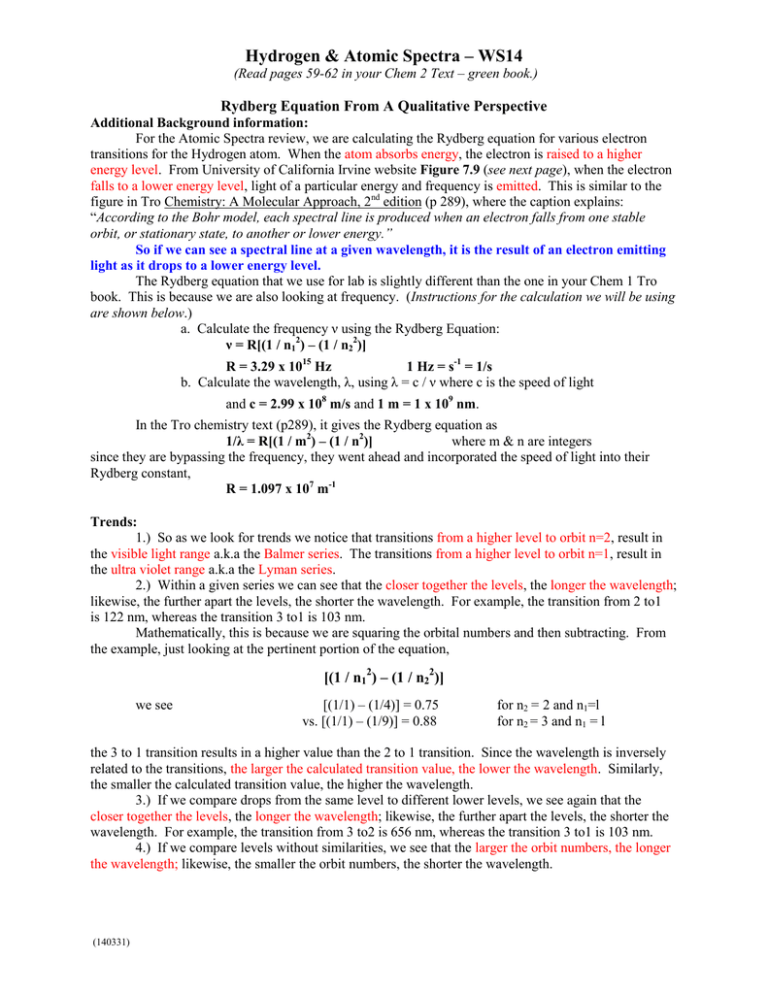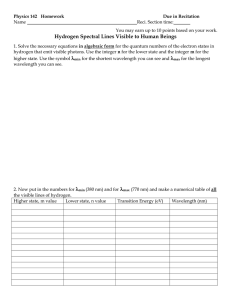Atomic Spectra Checklist
advertisement

Hydrogen & Atomic Spectra – WS14 (Read pages 59-62 in your Chem 2 Text – green book.) Rydberg Equation From A Qualitative Perspective Additional Background information: For the Atomic Spectra review, we are calculating the Rydberg equation for various electron transitions for the Hydrogen atom. When the atom absorbs energy, the electron is raised to a higher energy level. From University of California Irvine website Figure 7.9 (see next page), when the electron falls to a lower energy level, light of a particular energy and frequency is emitted. This is similar to the figure in Tro Chemistry: A Molecular Approach, 2nd edition (p 289), where the caption explains: “According to the Bohr model, each spectral line is produced when an electron falls from one stable orbit, or stationary state, to another or lower energy.” So if we can see a spectral line at a given wavelength, it is the result of an electron emitting light as it drops to a lower energy level. The Rydberg equation that we use for lab is slightly different than the one in your Chem 1 Tro book. This is because we are also looking at frequency. (Instructions for the calculation we will be using are shown below.) a. Calculate the frequency ν using the Rydberg Equation: ν = R[(1 / n12) – (1 / n22)] R = 3.29 x 1015 Hz 1 Hz = s-1 = 1/s b. Calculate the wavelength, λ, using λ = c / ν where c is the speed of light and c = 2.99 x 108 m/s and 1 m = 1 x 109 nm. In the Tro chemistry text (p289), it gives the Rydberg equation as 1/λ = R[(1 / m2) – (1 / n2)] where m & n are integers since they are bypassing the frequency, they went ahead and incorporated the speed of light into their Rydberg constant, R = 1.097 x 107 m-1 Trends: 1.) So as we look for trends we notice that transitions from a higher level to orbit n=2, result in the visible light range a.k.a the Balmer series. The transitions from a higher level to orbit n=1, result in the ultra violet range a.k.a the Lyman series. 2.) Within a given series we can see that the closer together the levels, the longer the wavelength; likewise, the further apart the levels, the shorter the wavelength. For example, the transition from 2 to1 is 122 nm, whereas the transition 3 to1 is 103 nm. Mathematically, this is because we are squaring the orbital numbers and then subtracting. From the example, just looking at the pertinent portion of the equation, [(1 / n12) – (1 / n22)] we see [(1/1) – (1/4)] = 0.75 vs. [(1/1) – (1/9)] = 0.88 for n2 = 2 and n1=l for n2 = 3 and n1 = l the 3 to 1 transition results in a higher value than the 2 to 1 transition. Since the wavelength is inversely related to the transitions, the larger the calculated transition value, the lower the wavelength. Similarly, the smaller the calculated transition value, the higher the wavelength. 3.) If we compare drops from the same level to different lower levels, we see again that the closer together the levels, the longer the wavelength; likewise, the further apart the levels, the shorter the wavelength. For example, the transition from 3 to2 is 656 nm, whereas the transition 3 to1 is 103 nm. 4.) If we compare levels without similarities, we see that the larger the orbit numbers, the longer the wavelength; likewise, the smaller the orbit numbers, the shorter the wavelength. (140331) Additional Thoughts: From Tro, 2nd ed. (p 301), Conceptual Connection 7.3 Emission Spectra, they tie in the energy differences associated with the orbital transitions. Specifically, Which transition will result in emitted light with the shortest wavelength? a.) n = 5 → n = 4 b.) n = 4 → n = 3 c.) n = 3 → n = 2 Answer: c.) The energy difference between n=3 and n=2 is greatest because the energy differences get closer together with increasing n. The greater the energy difference results in an emitted photon of greater energy and therefore shorter wavelength. University of California Irvine website: https://eee.uci.edu/programs/hongchem/RDGEmissionLines.pdf When a hydrogen atom absorbs energy, as it does when an electric discharge passes through it, the electron is raised from the orbit having n = 1 to a higher orbit, to n = 2 or n = 3 or even higher. The hydrogen atom is now in an excited state. These higher orbits are less stable than the lower ones, so the electron quickly drops to a lower orbit. When this happens, energy is emitted in the form of light (see Figure 7.9). Since the energy of the electron in a given orbit is fixed, a drop from one particular orbit to another, say, from n = 2 to n = 1, always releases the same amount of energy, and the frequency of the light emitted because of this change is always precisely the same. (140331) Name: __________________________________ Date ____________ Section __________ Hydrogen & Atomic Spectra – WS14 Part A: Line Spectrum of Hydrogen Gas Using Rydberg's equation calculate the wavelength of the radiation emitted by a hydrogen atom for the following electronic transitions: a. Calculate the frequency, ν (nu), using the Rydberg Equation: ν = R[(1 / n12) – (1 / n22)] R = 3.29 x 1015 Hz 1 Hz = s-1 = 1/s b. Calculate the wavelength, λ (lambda), using λ = c / ν where c is the speed of light and c = 2.99 x 108 m/s and 1 m = 1 x 109 nm. c. Show calculations in space provided. d. Indicate whether these transitions belong to Balmer series (visible light) or Lyman series (ultraviolet light). Transition between the levels Wavelength λ of the emitted radiation (nm) (Show calculation.) Balmer or Lyman n2 = 3 and n1=2 n2 = 4 and n1=2 n2 = 5 and n1=2 n2 = 2 and n1=l n2 = 3 and n1 = l Part B: Observed lines for hydrogen gas from the spectroscope. The class ran the spectroscope three times and observed peaks at the wavelengths listed below in the observation section. a. Calculate the average of the observations given and record. b. Using the table above, determine the transitions corresponding to your average observations and record in the space provided. c. Referring to the visible spectrum (green book page 62), determine the color of the observed wavelengths. Observations (nm) (140331) Average Wavelength (nm) Represented transitions 650, 658, 648 n2 = ______ and n1 = ______ 484, 489, 482 n2 = ______ and n1 = ______ 439, 435, 431 n2= ______ and n1 = ______ Color of wavelength Part C: Energy Diagram & Bohr Model for the Hydrogen atom 1. On the Energy Diagram and the Bohr’s atom provided a.) label the energy levels and b.) draw the transition arrows and label them and for all of the Hydrogen gas transitions (Part A – both visible & ultraviolet); and then, c.) show how the transitions correspond to the observed spectral lines for the Balmer series. a.) Energy Levels b.) Electron Transitions (Arrows) c.) Emission Spectrum – use the appropriate color when drawing in the spectral lines. 2. Why does the Hydrogen spectrum have the fewest lines? (Compared to other elements.) 3. For the Hydrogen spectrum, the red line appears more intense (brighter) than the other lines. Explain why the red line is more intense. 4. When a colored light is observed, is it the result of electrons absorbing or emitting energy? 5. Using a STAR Spectroscope, a student observed peaks at the following wavelengths in nm: 428, 480, & 646. The TA listed the accepted values as 433, 485 & 654 nm. Based on these accepted values & using the closest value to the observed value, determine the Percent Error for the following wavelength only : 480. (Show the calculation in the space provided.) (140331)





